
Based on the customer’ss end product types (reactive power relays, power factor controllers, industrial control and protection modules, etc.) and supercapacitor parameter requirements (0.47F/1F, -25~+85℃, 3.3/3.6VDC), the core reason for requiring a maximum leakage current ≤ 2μA is essentially to ensure three key needs of the end equipment: power supply stability, functional reliability, and energy consumption control. The details can be broken down by product application scenarios as follows:
The customer’s products are mostly industrial-grade control/measurement modules. These devices generally have the characteristics of "intermittent operation" or "long-term standby". The supercapacitor’s main role is usually "backup power supply" (e.g., maintaining data storage and emergency reset during power outages) or "short-term power supplement" (e.g., compensating for instantaneous peak current). In both scenarios, leakage current directly affects the supercapacitor’s "effective power supply capacity", specifically:
Prevent backup power from being "depleted in advance" to ensure critical functions during power outagesDuring normal operation, industrial control modules (such as compensation relays and protection modules) are powered by external power sources, and the supercapacitor is in a "float charging standby" state. Once the external power is cut off, the supercapacitor must immediately release electrical energy to maintain key functions such as data storage (e.g., historical measurement values, device parameters), emergency alarms, and module reset (usually for a few seconds to several minutes). If the leakage current is too high (like Kamcap’s high leakage current), the supercapacitor will discharge slowly due to "continuous leakage" even when the device is working normally. This causes the capacitor to have no remaining power when a real power outage occurs, leading to direct failure. A leakage current ≤ 2μA can minimize "standby loss" and ensure the capacitor is "powered when needed".
For example: Assume a supercapacitor with a capacity of 1F and a rated voltage of 3.6V. Calculated at a leakage current of 2μA, the voltage drop rate caused by leakage is approximately I=C×(ΔV/Δt) → ΔV/Δt = I/C = 2μA / 1F = 2μV/s. It only drops by about 0.17V in one day (86400s), maintaining "full charge standby" for a long time. If the leakage current reaches 10μA, the voltage drops by 0.86V in one day and will be lower than the minimum operating voltage of 3.3V after one week, completely losing its backup power function.
Avoid interfering with "low-power standby mode" and reduce the overall energy consumption of the deviceSome of the customer’s products (such as energy measurement analyzers and automation control modules) may require "long-term low-power standby" (e.g., waking up every few minutes for data collection). At this time, the overall power consumption of the device is already controlled at the level of tens to hundreds of μA. If the supercapacitor’s leakage current is too high (e.g., exceeding 10μA), its leakage loss will become the "main part" of the device’s standby energy consumption. This not only fails to meet the low-energy requirements of industrial equipment but also may cause external power sources (such as lithium batteries and low-voltage DC power supplies) to be depleted in advance, increasing maintenance costs.
The customer’s products include "high-precision measurement/control equipment" such as power factor controllers, energy measurement analyzers, and reactive power relays. These devices have extremely high requirements for the "stability" and "interference resistance" of the power supply voltage. Excessive leakage current will indirectly affect functional accuracy:
Avoid power supply voltage fluctuations and prevent false triggering of control logic
If the supercapacitor is connected in parallel in the device’s power supply circuit (e.g., to stabilize instantaneous voltage fluctuations), leakage current will cause a "continuous small current" in the circuit. If the leakage current is unstable (e.g., fluctuating with temperature changes), it will cause small fluctuations in the power supply voltage. For devices like power factor controllers, their control thresholds are usually precise to 0.01 (e.g., power factor 0.95~1.0). Small fluctuations in the power supply voltage may lead to incorrect judgment of the "reactive power state", thereby falsely triggering the switching of compensation capacitors and affecting power grid stability.
Reduce "stray current" caused by leakage current to ensure measurement accuracy
Energy measurement analyzers need to collect small current/voltage signals (such as mA-level current and mV-level voltage). If the supercapacitor’s leakage current is too high, the "stray current" generated by the leakage may interfere with the measurement circuit, leading to deviations in measurement values (e.g., increased current measurement errors), which fails to meet the measurement accuracy standards of industrial equipment (usually requiring ±0.5% or less).
The customer clearly requires the supercapacitor to operate at a temperature range of -25~+85℃ (a common industrial-grade wide temperature range). The leakage current of supercapacitors increases significantly with temperature (electrolyte ion activity enhances, and leakage current may double or even multiply). If the initial leakage current is already high (like Kamcap’s products), the leakage current may far exceed 2μA in a high-temperature environment of 85℃. This not only exacerbates the problems of "backup power depletion" and "excessive energy consumption" but also may cause internal heating of the capacitor due to long-term high leakage, accelerating electrolyte aging, shortening the capacitor’s service life (industrial equipment usually requires a service life of 5~10 years), and increasing equipment failure rates and replacement costs.
Summary: The Essence of Leakage Current ≤ 2μA is to "Adapt to the Core Scenario Needs of End Products"
The customer’s demand is not simply to "pursue low leakage current", but to ensure that the supercapacitor can work stably in four major scenarios: "industrial-grade wide temperature, low-power standby, high-precision control/measurement, and long-term backup power supply" by controlling leakage current. Ultimately, this guarantees the reliability, stability, and service life of the end equipment — which is the core reason they excluded Kamcap (due to its high leakage current).。
UF capacitors produce super capacitors to replace tier-1 like #Eaton #KR series, #ELNA #DB series, #Korchip #DCS etc. Excellent Lead time 2-3 weeks, kindly send RFQ to connie@ufcapacitors.com for quotation in free. Thanks,
#super_capacitors #Fara_capacitors #coin #UFcapacitors #Cost_down